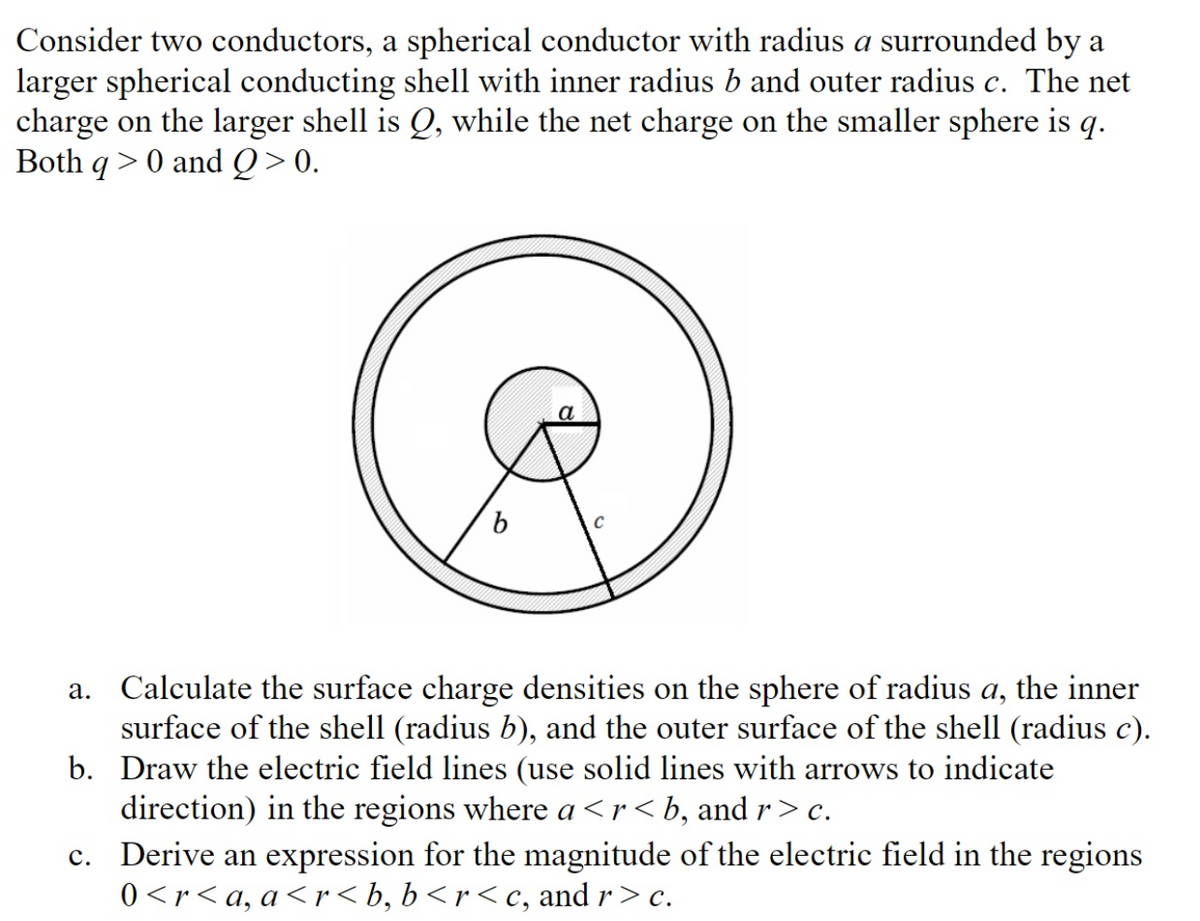Consider two conductors, a spherical conductor with radius a surrounded by a larger spherical conducting shell with inner radius b and outer radius c. The net charge on the larger shell is Q, while the net charge on the smaller sphere is q. Both q> 0 andQ>0. a. Calculate the surface charge densities on the sphere of radius a, the inner surface of the shell (radius b), and the outer surface of the shell (radius c). b. Draw the electric field lines (use solid lines with arrows to indicate direction) in the regions where a c. c. Derive an expression for the magnitude of the electric field in the regions 0 c.
Consider two conductors, a spherical conductor with radius a surrounded by a larger spherical conducting shell with inner radius b and outer radius c. The net charge on the larger shell is Q, while the net charge on the smaller sphere is q. Both q> 0 andQ>0. a. Calculate the surface charge densities on the sphere of radius a, the inner surface of the shell (radius b), and the outer surface of the shell (radius c). b. Draw the electric field lines (use solid lines with arrows to indicate direction) in the regions where a c. c. Derive an expression for the magnitude of the electric field in the regions 0 c.
Introductory Circuit Analysis (13th Edition)
13th Edition
ISBN:9780133923605
Author:Robert L. Boylestad
Publisher:Robert L. Boylestad
Chapter1: Introduction
Section: Chapter Questions
Problem 1P: Visit your local library (at school or home) and describe the extent to which it provides literature...
Related questions
Question
Need help with all parts pls

Transcribed Image Text:Consider two conductors, a spherical conductor with radius a surrounded by a
larger spherical conducting shell with inner radius b and outer radius c. The net
charge on the larger shell is Q, while the net charge on the smaller sphere is q.
Both q> 0 andQ>0.
a. Calculate the surface charge densities on the sphere of radius a, the inner
surface of the shell (radius b), and the outer surface of the shell (radius c).
b. Draw the electric field lines (use solid lines with arrows to indicate
direction) in the regions where a<r<b, and r >c.
c. Derive an expression for the magnitude of the electric field in the regions
0 <r< a, a<r < b, b< r < c, and r> c.
Expert Solution
This question has been solved!
Explore an expertly crafted, step-by-step solution for a thorough understanding of key concepts.
This is a popular solution!
Trending now
This is a popular solution!
Step by step
Solved in 2 steps with 1 images

Knowledge Booster
Learn more about
Need a deep-dive on the concept behind this application? Look no further. Learn more about this topic, electrical-engineering and related others by exploring similar questions and additional content below.Recommended textbooks for you

Introductory Circuit Analysis (13th Edition)
Electrical Engineering
ISBN:
9780133923605
Author:
Robert L. Boylestad
Publisher:
PEARSON

Delmar's Standard Textbook Of Electricity
Electrical Engineering
ISBN:
9781337900348
Author:
Stephen L. Herman
Publisher:
Cengage Learning

Programmable Logic Controllers
Electrical Engineering
ISBN:
9780073373843
Author:
Frank D. Petruzella
Publisher:
McGraw-Hill Education

Introductory Circuit Analysis (13th Edition)
Electrical Engineering
ISBN:
9780133923605
Author:
Robert L. Boylestad
Publisher:
PEARSON

Delmar's Standard Textbook Of Electricity
Electrical Engineering
ISBN:
9781337900348
Author:
Stephen L. Herman
Publisher:
Cengage Learning

Programmable Logic Controllers
Electrical Engineering
ISBN:
9780073373843
Author:
Frank D. Petruzella
Publisher:
McGraw-Hill Education

Fundamentals of Electric Circuits
Electrical Engineering
ISBN:
9780078028229
Author:
Charles K Alexander, Matthew Sadiku
Publisher:
McGraw-Hill Education

Electric Circuits. (11th Edition)
Electrical Engineering
ISBN:
9780134746968
Author:
James W. Nilsson, Susan Riedel
Publisher:
PEARSON

Engineering Electromagnetics
Electrical Engineering
ISBN:
9780078028151
Author:
Hayt, William H. (william Hart), Jr, BUCK, John A.
Publisher:
Mcgraw-hill Education,